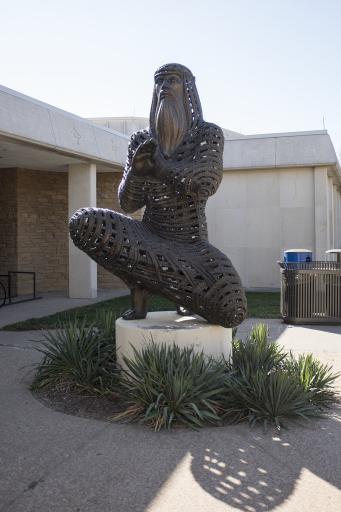Audio Tour – Bulldog Podcast
The bronze Moses statue, created by Elden Cecil Tefft, stands ten feet tall outside of Smith Hall, the religious studies building. Elden C. Tefft is a world-renowned bronze sculptor who also created the Lawrence High Chesty Lion and the bronze Academic Jay that sits in front of Strong Hall at the University of Kansas. He was a KU professor for many years and founded the International Sculpture Center. The Moses statue is a gift of Corinne Wooten Miller of Tonganoxie, given in memory of her husband, Charles E. Miller. The stained glass window “Burning Bush,” sits across from the Moses statue and was designed by Smith Hall architect Charles L. Marshall. Mr. and Mrs. L. Allyn Laybourn donated the window in memory of his parents.
Relating to the meaning behind the artistic piece, fire is a symbol of knowledge in many myths and stories. In the biblical story of Exodus, God speaks to Moses through a burning bush. He tells Moses that he has seen the Israelites struggling with slavery at the hands of the Egyptians. He sends Moses to Pharaoh to bring God’s people out of slavery and to a “spacious land, a land flowing with milk and honey.” The sculpture, facing the stained glass window, illustrates the knowledge passed to Moses from God and is appropriate given the religious education provided at this location.
The Moses statue is kneeling, with hands together in prayer. His eyes are locked on a burning bush and it appears that his clothing is made of ribbons. The bible mentions ribbons in Numbers 15:38-39, “Speak unto the children of Israel, and bid them that they make them fringes in the borders of their garments throughout their generations, and that they put upon the fringe of the borders a ribbon of blue. And it shall be unto you for a fringe, that ye may look upon it, and remember all the commandments of the Lord, and do them...” In this scripture, the word “ribbon” refers to bound lace, twine, or thread and the blue ribbon is a tool for remembering God’s commandments. After the Israelite people escaped Egypt they came across a mountain named Mount Sinai, where Moses left them and went up to receive the Ten Commandments. The Moses statue with clothing seemingly made of ribbons, appears to be symbolic of the fact that Moses was a messenger of God and provided God’s commandments to the people.
The great challenges Moses experienced in his life required him to be brave and have great leadership skills. The students at the University of Kansas must also have courage when they start out on their college career. Seeing the Moses statue may help remind them of the Ten Commandments and overall make the University a better place. Each time I see the statue I am reminded that some things must be done, that may not be comfortable, for the better of other people. Moses stood up to Pharaoh and ultimately freed the Israelites from slavery. He also listened to God and shared the knowledge he learned with the Israelites. This meaningful statue fits in perfectly on a college campus due to its many encouraging reminders.
This has been Morgan Goeser with another Bulldog Podcast.

